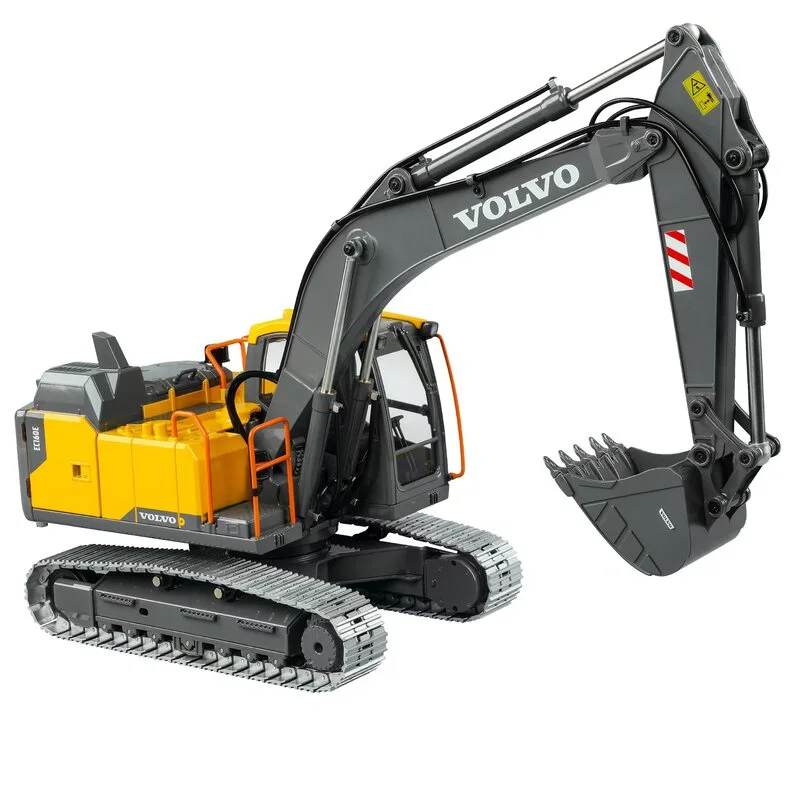Recognizing Exactly How Excavator Works and Its Effect On Efficiency
Excavators play a vital duty in building and mining operations, counting on a complex interaction of hydraulic and mechanical systems. Their capability to execute a range of jobs depends upon both their layout and the innovation integrated within. Understanding these parts can substantially affect operational efficiency and performance. As improvements continue to reshape the sector, one should take into consideration exactly how these adjustments will influence future techniques and performance.
The Basics of Excavator Mechanics

The Duty of Hydraulic Systems in Excavators
At the heart of excavator procedure exists the hydraulic system, which plays a critical function in powering the equipment's motions and features. This system uses pressurized hydraulic liquid to transfer energy, allowing different activities such as swinging, lifting, and digging. By harnessing the principles of hydraulics, excavators can perform tasks with amazing accuracy and force, boosting total functional efficiency.The hydraulic system is composed of vital parts, including pumps, valves, and cyndrical tubes, which collaborate to manage the flow and direction of the fluid. When the operator engages the controls, the hydraulic fluid is directed to specific cylinders, equating the operator's commands right into physical motion. This mechanism enables receptive and smooth actions, which are necessary in building and construction and excavation atmospheres. double e volvo rc excavator. The effectiveness of the hydraulic system directly impacts the performance and convenience of the excavator, making it an important aspect in contemporary excavation processes
Key Elements of an Excavator
Recognizing the key parts of an excavator is crucial for realizing just how this powerful device operates. An excavator includes a number of considerable components, including the undercarriage, house, container, arm, and boom. The undercarriage supplies stability and wheelchair, typically including wheels or tracks to navigate various surfaces. Your home consists of the engine and hydraulic systems, allowing the driver to control activity and power the maker. The boom extends from your house, allowing upright reach, while the arm links to the pail, assisting in digging and training operations.Additionally, the cab houses the driver, geared up with controls for exact handling. Each of these components plays a crucial duty in the excavator's overall performance, adding to its efficiency and efficiency on building and construction sites. Comprehending these components aids in maintaining and optimizing excavator efficiency, ensuring tasks are finished safely and efficiently.
Accessory Versatility and Its Advantages
Attachment flexibility is a vital aspect of excavators, allowing operators to switch over in between various tools customized for details jobs. This versatility not just improves work performance but additionally contributes to cost-effectiveness by decreasing the requirement for numerous machines. Understanding the different kinds of add-ons readily available can significantly affect the general efficiency and performance of an excavator on work sites.
Kinds of Attachments
While excavators are primarily identified for their excavating capacities, their real adaptability depends on the broad range of attachments available. These attachments enhance the excavator's capability, enabling it to do numerous jobs past excavation. Typical add-ons consist of pails (for excavating and scooping), hydraulic thumbs (for realizing products), and augers (for piercing holes) Grapples are used for relocating and managing debris, while rippers can separate tough surfaces. Other specialized add-ons, such as trenchers and rakes, enable excavators to adjust to particular work needs. This diversity not only raises the equipment's utility across various fields, consisting of demolition, building, and landscaping, but additionally enables drivers to tailor their equipment to satisfy certain project demands successfully.
Boosted Job Performance
Optimizing job performance is a primary benefit of utilizing numerous excavator accessories. Various accessories permit an excavator to carry out numerous tasks without requiring to change devices, conserving useful time and labor. As an example, utilizing a hydraulic hammer can damage concrete while a container attachment can dig deep into soil, allowing a seamless process. This versatility reduces downtime related to devices modifications and improves performance on-site. Additionally, specialized accessories enhance accuracy in tasks such as grading or landscaping, leading to higher high quality end results. The ability to adapt to different work needs not only improves procedures yet also lessens the requirement for extra equipment, making sure that projects are finished promptly and successfully. Overall, accessory adaptability substantially adds to increased job effectiveness in excavation job.
Cost-Effectiveness and Convenience
Cost-effectiveness is a considerable benefit of utilizing versatile excavator attachments. These add-ons allow a single excavator to carry out several jobs, lowering the requirement for extra machinery and labor - double e volvo rc excavator. By switching over in between containers, hammers, and grapples, operators can deal with different tasks, from digging to demolition, thereby optimizing equipment usage. This adaptability not only reduces operational expenses yet also decreases downtime related to transforming tools. Furthermore, the capacity to personalize excavators with specialized accessories enhances productivity, as they can successfully deal with diverse jobs according to job demands. To conclude, the mix of cost-effectiveness and flexibility in excavator attachments adds to enhanced functional effectiveness and resource allowance in construction and excavation tasks

Advanced Innovation in Modern Excavators
Modern excavators are progressively equipped with innovative modern technology that transforms excavation procedures. Automation improves operations, while enhanced gas effectiveness decreases operational prices. Furthermore, smart control systems boost accuracy and safety and security, noting a considerable evolution in excavation devices.
Automation in Excavation Processes
As excavation technology evolves, automation has actually become an important element in improving efficiency and precision on work sites. Modern excavators are furnished with advanced automated systems that promote tasks such as grading, digging, and trenching with minimal driver treatment. These systems utilize sensing units, GPS, and artificial intelligence formulas to guarantee precise placing and deepness control, significantly lowering the margin for error. In addition, automation allows operators to focus on tactical decision-making as opposed to manual controls, causing improved efficiency on the whole. Such developments not just streamline process however also improve safety and security by minimizing human error in intricate procedures. Consequently, the assimilation of automation in excavation processes represents a significant innovation in building and construction technology, driving the sector in the direction of higher effectiveness and performance.
Improved Gas Effectiveness
Innovations in modern technology have likewise brought about considerable enhancements in gas effectiveness for modern excavators. Modern makers are outfitted with innovative engines that maximize power output while reducing fuel usage. These engines use ingenious burning technologies, such as turbocharging and direct gas injection, to improve performance and efficiency. Additionally, light-weight products in building minimize general weight, enabling less power expense during operation. The introduction of variable rate controls allows operators official website to adjust engine efficiency according to certain tasks, further decreasing gas use. As an outcome, these improvements not only reduced functional costs yet likewise add to ecological sustainability by lowering discharges. In general, enhanced gas effectiveness in excavators is a necessary advancement that bolsters performance and economic viability in the building and construction industry.
Smart Control Equipment
While operators browse progressively complex work sites, clever control systems in excavators have arised as necessary tools for improving efficiency and accuracy. These sophisticated modern technologies use formulas and sensors to check various criteria such as tons weight, terrain problems, and operational performance. By automatically readjusting hydraulic features, wise systems enhance maker performance, leading to boosted productivity and decreased endure elements. Additionally, operators take advantage of intuitive user interfaces that give real-time feedback and diagnostics, permitting educated decision-making. This assimilation of technology not only simplifies operations but likewise decreases human mistake, adding to safer workplace. As the building and construction sector remains to develop, wise control systems will certainly play a vital role in forming the future of excavator performance and effectiveness.
Enhancing Operational Effectiveness With Excavators
Excavators play an important function in boosting functional effectiveness across different building and construction and excavation tasks. Their versatility enables several jobs, consisting of material, excavating, and training handling, which improves workflows and decreases the requirement for extra devices. With powerful hydraulic systems, excavators can carry out heavy-duty jobs with precision, significantly decreasing the moment called for to total jobs. The integration of advanced technology, such as general practitioner and automated controls, better maximizes their operation, enabling drivers to attain higher precision and decrease material waste. In addition, modern-day excavators are developed to consume much less gas and lessen discharges, adding to both price savings and environmental sustainability. By making use of excavators properly, building and construction teams can enhance performance, meet task target dates, and enhance total website management. This multifunctionality and performance make excavators crucial devices in the modern construction landscape.
The Future of Excavators in Construction and Mining Industries
As the building and construction and mining sectors develop, the future of excavators is poised for substantial change driven by technical advancement and changing functional demands. Advances in automation and expert system are improving excavator abilities, enabling for improved accuracy and effectiveness in procedures. Self-governing excavators are emerging, lowering the demand for human intervention and minimizing the danger of accidents.Moreover, the assimilation of telematics and IoT innovation enables real-time tracking of maker efficiency and predictive maintenance, maximizing uptime. Green designs, including electrical and hybrid models, are acquiring grip, straightening with sustainability goals within the industry.Additionally, making use of sophisticated products and lighter layouts boosts gas efficiency while maintaining performance requirements. As these patterns progress, excavators will play an essential role in meeting the boosting needs for performance and safety in building and mining, eventually changing functional landscapes.
Frequently Asked Questions
How Do Weather Influence Excavator Performance?

Weather greatly affect excavator efficiency, as rain and mud can impede traction and security, while extreme temperatures might impact hydraulic systems. Operators should adapt to these variables to guarantee perfect functionality and safety during procedures.
What Precaution Should Operators Follow While Using Excavators?
Precaution for excavator operators include using proper personal safety tools, carrying out pre-operation inspections, making certain proper interaction with ground employees, preserving a risk-free distance from overhanging risks, and adhering to established operational procedures to stop crashes.
How Usually Should Excavators Be Preserved for Optimum Performance?
Excavators need to look at here now be preserved routinely to assure peak performance, normally every 250 operating hours or as defined by the producer. Regular checks enhance dependability, protect against unforeseen failures, and extend the life expectancy of the tools.
What Is the Typical Life-span of an Excavator?
The average life expectancy of an excavator commonly ranges from 10,000 to 15,000 hours of operation. Aspects affecting longevity include upkeep practices, operating problems, and the top quality of the machine itself, affecting general performance and efficiency.

Can Excavators Operate Uneven Terrain Successfully?
Excavators can run effectively on unequal surface as a result of their check my site articulated designs and adjustable tracks. These functions permit them to keep stability and grip, making it possible for efficient operation in difficult settings commonly encountered in building and landscape design tasks. Each of these components plays an essential function in the excavator's total capability, adding to its performance and performance on construction sites. Making the most of job performance is a key advantage of utilizing various excavator add-ons. While operators navigate significantly intricate work sites, wise control systems in excavators have arised as vital tools for enhancing effectiveness and accuracy. Excavators play a vital function in improving functional performance across various construction and excavation tasks. Breakthroughs in automation and man-made intelligence are improving excavator capacities, permitting for boosted accuracy and effectiveness in operations.